Learn how to improve your child’s cutting skills with these simple tips from a pediatric OT. *This post contains affiliate links
How to Improve Your Child’s Cutting Skills
“Cutting?” The mom looked at me nervously…. “Um, I’ve never given my child scissors…. I don’t want him to hurt himself….” Her face turned red. “Should I?!”
The poor mom was panicking as she asked me about kindergarten. She was totally nervous that her son wouldn’t be able to keep up. Trying to reassure her, I asked how he holds his pencil and how were his cutting skills. And instead of making her feel better, I made it way worse! Uh-oh.
(This happens all the time, by the way. Moms don’t realize that kids should be cutting WAY before Kindergarten. But really – if you are worried that your kid will hurt themselves when they are sitting with you in the kitchen, do you really want them learning how to cut while the teacher is also supervising 20 other kids? )
Nah – better to get them started before school so they know what they are doing. It gives them a “leg up” on the rest of the kids. You can always give them those little safety scissors if you are worried that they will cut themselves. Or the playdoh scissors, which don’t have real blades.
“Fine motor skills & Cutting” is part of a series called Functional Skills for Kids. This will include developmental topics that impact functional skills for kids.
This is a wonderful resource for parents, teachers, and therapists to learn about all the different activities a child performs each day. Each childhood function is broken down into developmental timelines, fine motor considerations, gross motor considerations, sensory considerations, visual perceptual considerations, accommodations and modifications, activity ideas, and more.
This topic is Cutting, so check out all the “Functional Skills for Kids.”
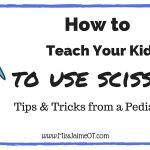
HOW TO improve your child’s cutting skills
So anyway – there are a few hard things about learning how to cut. And it takes a while for kids to get comfortable. Another reason why I am a fan of starting early…..
- Remembering not to cut your hair, your shirt, or your finger. Always important.
- Figuring out how to hold the scissors and which fingers go in which hole.
- Motor planning how to open and shut your fingers, which requires separation of the two sides of the hand.
- Holding the paper with your other hand (one job for your brain) and managing the blades of the scissors (another job) with the other hands WHILE keeping the scissors on the line (third job). Oh, and don’t forget “keep your eyes on the paper to see what you are doing”. Whew.
If you read my last post about fine motor skills, you saw this graphic which I think explains fine motor skills perfectly. It starts with your trunk and progresses downward to your fingers. So, in order to support your child in learning how to cut properly, you need to teach more than just how to use scissors.
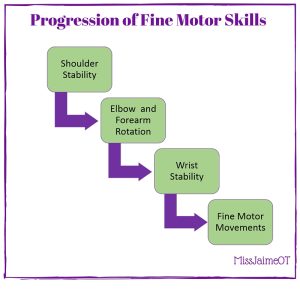
1) Position for cutting – Make sure your child is sitting at a table that is properly sized for them (AOTA, 2011). If they like to work at the kitchen table, use a booster seat so that their arms hang down a little. It’s crucial that kids don’t have their arms straight out (with the table up to their armpits). It just messes everything up. This is another reason why I LOVE child-sized furniture. (note: if your “big kid” is too cool for a Booster seat, try one that goes under the chair. Very cool.
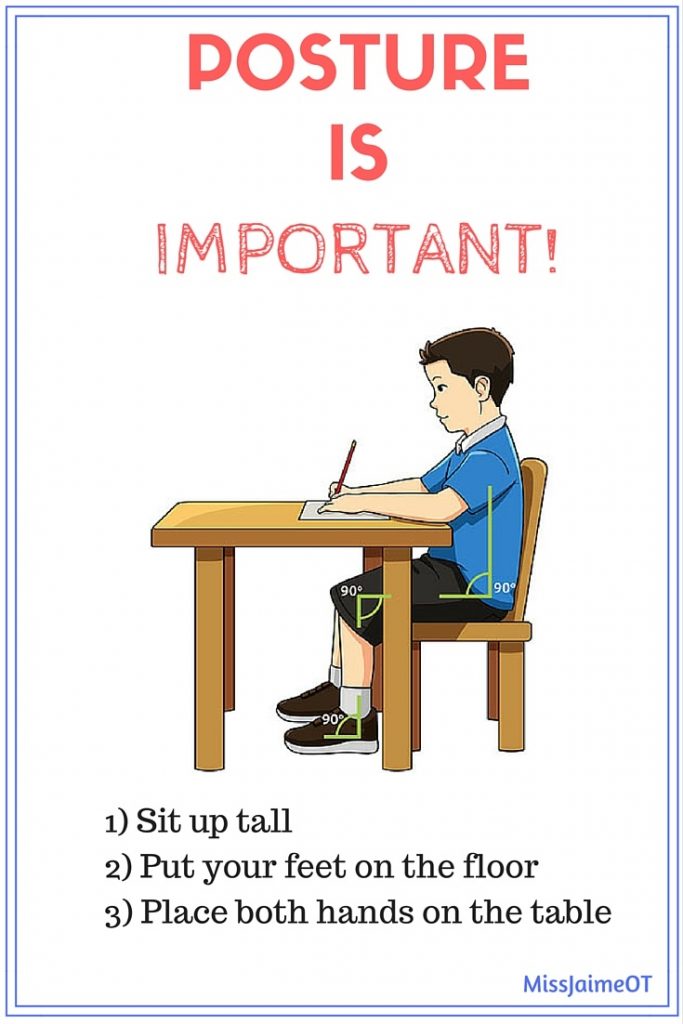
2. Shoulder stability – it seems like I’m always talking about shoulder stability lately. That’s because it is a significant developmental acquisition. (Kids who haven’t fully developed shoulder stability almost always have a tough time cutting. This is because it’s really tough to use your shoulder to cut! Kids compensate by elevating their shoulders, holding their elbows in the air, and twisting their wrists awkwardly. Ouch.)
I have an awesome trick for that, which I’ll get to in a minute.
Shoulder stability is the ability to keep your shoulder joint still (table) while moving your fingers. Think of a little kid learning how to scribble. They are working furiously, moving their whole arm back and forth to get the color on the paper. That’s because they are still developing their fine motor skills, and they have learned to compensate by using their whole arm. Toddlers do this naturally, and older kids often revert to this when their hand/fingers get tired.
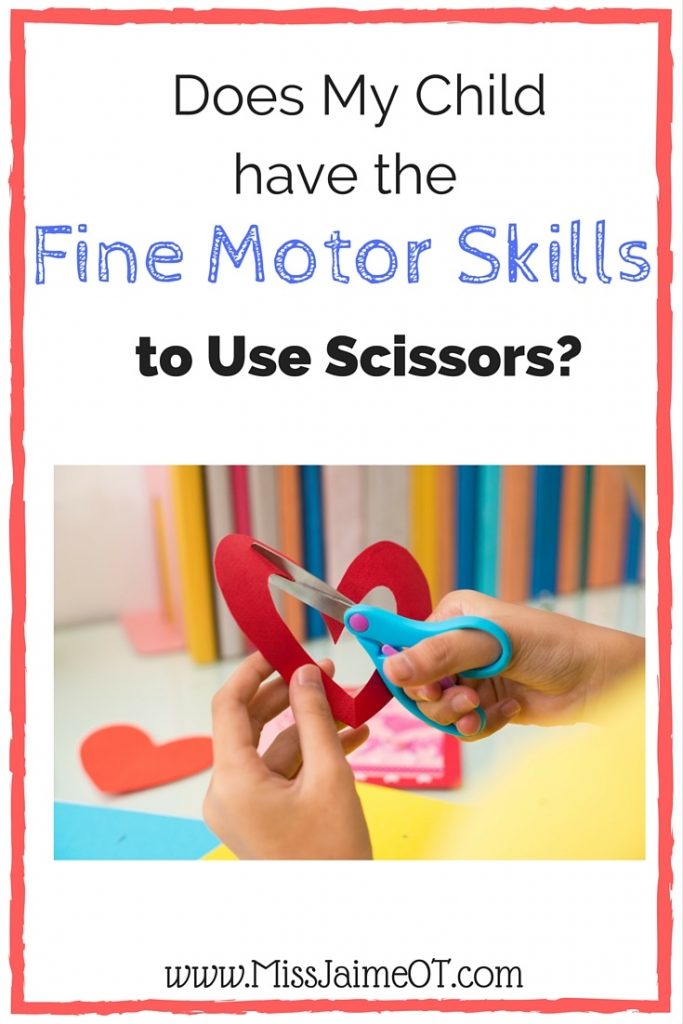
For more information about how to help your child develop shoulder stability, read here. But, I really want to share my favorite secret for helping kids with poor shoulder stability position their bodies correctly:
Have the child hold a folder or a large piece of paper between their body and their arm. This forces the elbow in and the shoulder down. It puts the forearm and wrist in the proper position. This is half the battle!

(I taught this trick in a teacher workshop recently, and one of my kindergarten teachers loved it so much that she started using it with her entire class. The kids thought it was so fun, and they were cutting better almost immediately. Great work, Miss O’Brien!)
3. Forearm position – the folder trick automatically puts a child’s arm in the proper position. One mistake that children often make is to tilt their scissors sideways or hold their scissors upside down. This is because it’s more comfortable for kids to use their arms when they are pronated (palms facing down). As fine motor skills develop, they become comfortable using their arm in a more mature neutral or supinated (palms up) position.
Once you have their bodies and arms positioned properly, you are ready for the next step. There are plenty of tricks to get your child to hold their scissors correctly. But I want to talk about how to help your child separate the two sides of their hand. This is really hard for kids, and it can affect how they hold their pencils, too. Have you ever seen a grip like this?
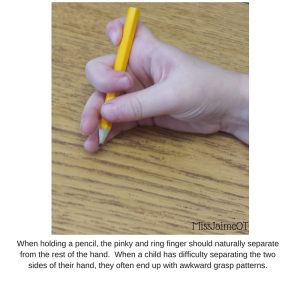
4. Separation of the two sides of the hand – This child has difficulty separating the two sides (pinky and thumb) of their hand – so they keep their index, middle, ring, and pinky fingers together. This doesn’t allow for proper movement of the thumb, which isn’t great for grasping a pencil, using scissors, or eating with a fork (Benbow, 1999). Children can practice using their fingers in isolation of each other by playing finger game songs like Thumbkin or itsy-bitsy spider. You can also practice counting on their fingers, making the “number signs” when talking about numbers (index and middle up for number two, etc.) These simple things are really great for getting kids to use their fingers. Playdoh activities and cookie making can help too!
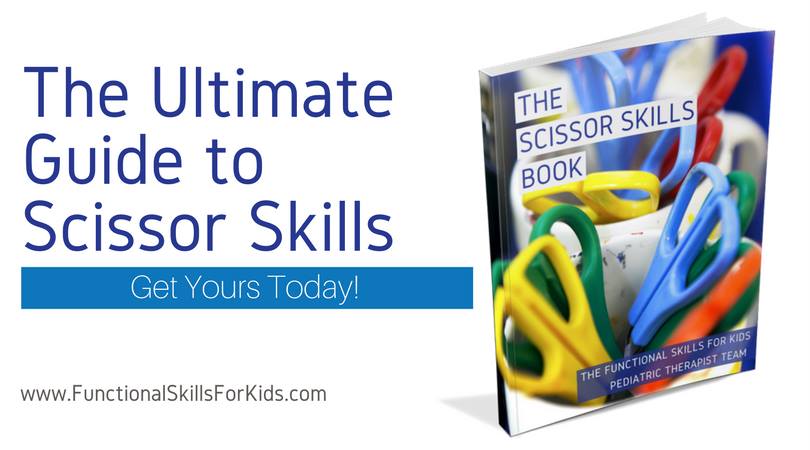
Many typical daily tasks require children to separate the two sides of their hand. This doesn’t come naturally for kids, and needs practice for it to become comfortable. Tweezers and tongs are great for practicing this, as well as fine motor toys like grabbers, strawberry hullers, or squeeze toys.
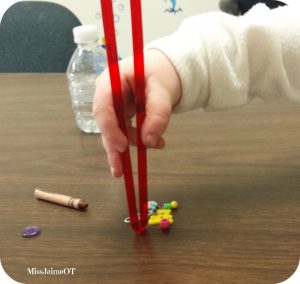
Learning to use scissors can be really tough without the proper fine motor skills. Don’t forget that any hand strengthening activity will help your child with cutting later on. Games and toys that encourage squeezing such as playdoh, clay, or spray bottles are tons of fun and great for strengthening! Tweezers and kitchen tongs work great, too.
References
FUNCTIONAL SKILLS FOR KIDS
“How to improve your child’s cutting skills” is part of the Functional Skills for Kids series. Check out all of the bloggers who are participating and learn more about the series by clicking on the link above.

Thanks for stopping by!




Love the “folder under the arm” tip!
Hi Jaime!
I am curious if you have your students hold classroom scissors with their index finger supporting the blades and the middle and ring fingers in the bottom loop.
Hi Jen,
I don’t do that with every child, but yes, with children who have very weak hands or low tone, I do teach them to keep their index finger out of the bottom loop. I find that it provides more stability for them.
Thanks Jamie – I always like to get a sense of what other OTs are doing – great point about kids with poor strength
Love all these tips
Hello
I think I sent you a question yesterday but not sure from which page I sent it and if I can only see answer coming back to this page…. If you did answer it, thanks…but I have to find answer.
I have tried working the 6 year old again with the scissors. I know it will take time because he has not used scissors until recently and I will try to work more with shoulder…. we are cutting play dough. But is there trick(s) for dealing with him keeping index finger extending all the way out when try to use scissors?
Hi Linda – it sounds like he needs a lot more practice. I would work on activities that encourage separation of the two pinky and thumb sides of his hand – use tongs, tweezers, etc. Keeping the index finger outside of the loop is actually ok for most kids, but not if it’s extended. Try the exercises for a while to strengthen his hand.